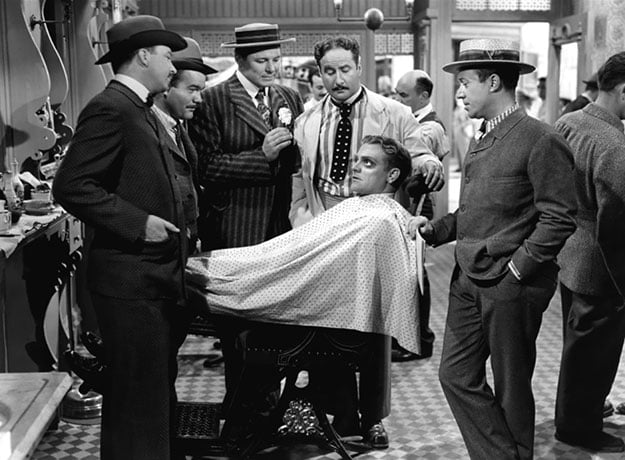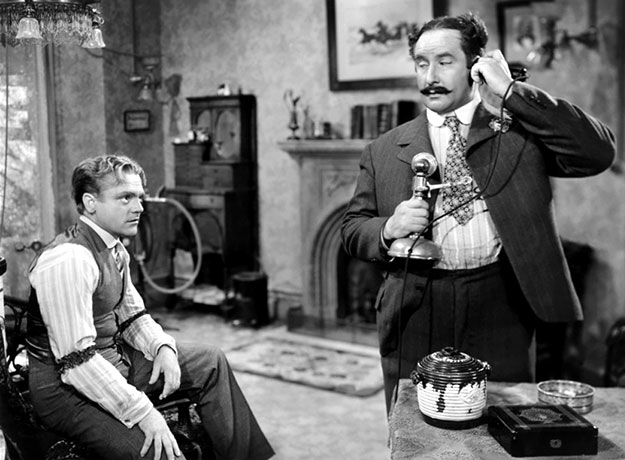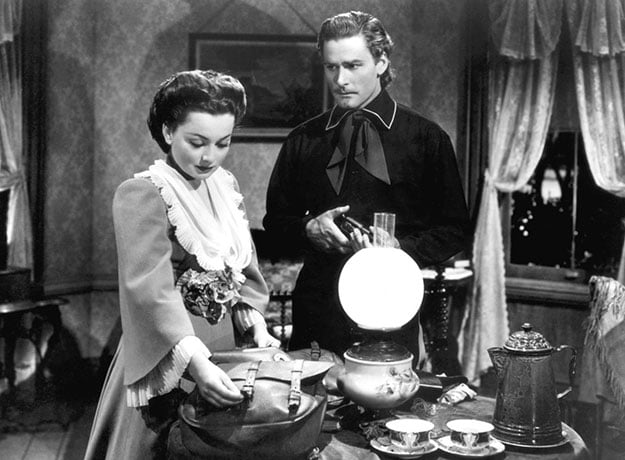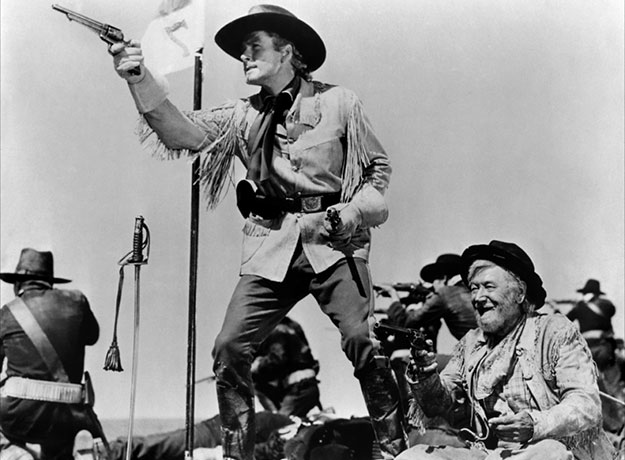TCM Diary: Raoul Walsh Looks Back

The Strawberry Blonde
In Woody Allen’s Midnight in Paris, a contemporary screenwriter played by Owen Wilson is whisked away to 1920s Paris, where he delights in mingling with his literary idols. Yet when he finds the girl of his dreams there, she yearns for the elegant, optimistic Belle Époque of a generation before. And when the two are mysteriously transported to that time, they find its denizens pining for the cultural surge of the Renaissance. Nostalgia, it turns out, doesn’t improve with age.
No one understood the perennial pull of nostalgia better than Raoul Walsh, who made a pair of films in 1941 that look back on the codes and customs of the late 19th century with pangs of fond regret. In The Strawberry Blonde and They Died with Their Boots On, Walsh offers more than a retreat to “simpler times”: together they form a cinematic Rosetta Stone for understanding the phenomenon of backwards longing. Revisiting these movies 75 years after they were made invites us to covet both the eras that produced them and the eras they depict, which seem equally distant to today’s viewer. (The online Dictionary of Obscure Sorrows offers the term “anemoia” to describe nostalgia for a time you never knew.)
The very name Raoul Walsh evokes sentimental stirrings, not only because he specialized in richly textured period pieces, but because perhaps more than any other great director, he embodies the durability, professionalism, and lack of vanity ascribed to studio workhorses. Walsh worked his way up the ranks on both sides of the camera. While playing John Wilkes Booth in The Birth of a Nation, he served as Griffith’s assistant director and co-editor, receiving no screen credit for any of it. A founding member of the Academy of Motion Picture Arts and Sciences, Walsh earned no nominations himself in a career encompassing such classics as The Big Trail, Gentleman Jim, and White Heat. In a cruel twist of fate, a car accident during the filming of In Old Arizona cost him his right eye and the starring role of The Cisco Kid. Though he continued on as director, the journeyman performer who replaced him, Warner Baxter, won the Oscar for Best Actor. Not one to dwell on his losses, Walsh channeled all his prodigious energy into directing from then on, and by the end of his five-decade career in 1964 had 138 filmmaking credits.

It’s probably fair to say that 1941 was his most fruitful year. He propelled Warner Bros. contract player Humphrey Bogart to stardom with High Sierra, and drew sterling performances from nearly all the studio’s top-tier actors: Edward G. Robinson and George Raft in Manpower, James Cagney in The Strawberry Blonde, and Errol Flynn in They Died with Their Boots On. The last two titles share star Olivia de Havilland and the complex outlook on the past that was one of Walsh’s signature strengths.
The Strawberry Blonde plants its characters in early 20th-century New York, where protagonist Biff Grimes (Cagney) is mired in wistful longing for his rough-and-tumble youth, rendered in flashbacks. Respectable adult Biff complains about the quaintly comforting activities his life is reduced to—playing horseshoes, taking Sunday strolls with wife Amy (de Havilland)—and lovingly recalls barroom brawls that required leeches from the local barber to bring down the swelling. He also has rosier-colored memories of days gone by—carriage rides through the park, Gay Nineties tunes like “The Band Played On”—but these are tied inextricably to his lost love: “strawberry blonde” Virginia Brush (Rita Hayworth in the role that solidified her stardom), taken away by blustering rich rival Hugo Barnstead (Jack Carson).
Throughout both eras, Walsh summons an age of cobblestone streets illuminated by gas lamps with such vividness that one forgets the studio artifice. Cagney is so captivating as the surly, competitive, utterly ingenuous Biff that at times he seems to be working magic. The Irish pugnacity and sawed-off self-assurance that made him the star of Tin Pan Alley in Yankee Doodle Dandy and the Bowery of Angels with Dirty Faces finds equal purchase in Biff’s gamecock crows (“That’s the kind of a hairpin I am!”) and hometown pride (he resents Virginia’s “reaching out into the sticks” of Brooklyn for dates). The world conjured by Walsh is so appealing that one has no trouble sharing Biff’s nostalgia for the beer halls, band concerts, and park benches of yore, and above all for the unspeakably alluring Virginia.

They Died with Their Boots On
But Walsh’s neatest trick is to invest Virginia with the selfsame qualities we necessarily filter out when we glorify the past. She’s conventionally closed-minded (especially compared to the forward-thinking Amy), doesn’t count the cost of her ambition (choosing immoral entrepreneur Hugo over hardworking dentist Biff), and is more pleasantly remembered than experienced. Hayworth layers all these shortcomings into her portrayal, and then coats it with a glamorous sheen that could blind better men than Biff. The ultimate fate of Hugo and Virginia reassures Biff (and the audience) that sometimes things work out for the best, despite the crippling urge to second-guess one’s choices on dull Sunday afternoons. Nostalgia has its place, but it can also stand in the way of appreciating and fully embracing the present. If Walsh chose to implant that lesson in a glittering valentine to the past, well, that’s just the kind of hairpin he was.
From the lofty perch of our more enlightened age, They Died with Their Boots On is the easiest type of film to patronize—which is why it should be taken seriously. Walsh’s romantic portrait of George Armstrong Custer (Flynn) spans the hero’s years as a West Point cadet to his infamous last stand at Little Bighorn, presenting a Custer who, while self-aggrandizing and indifferent to the chain of command, epitomized the noblest qualities of the gentleman soldier and fought for fair treatment of Native Americans. The film is guilty of shifting the blame for broken treaties to greedy speculators (which doubtless resonated with a nation recovering from the Great Depression). But that’s less an elision of problematic history than part of an elegy for the chivalrous warrior who questioned unconscionable orders. However detached he may be from the actual Custer, the man played by Flynn is a corrective to both hagiographic biopics and dogmatists who refuse to consider them in context.
Any notion of Custer as a man in lockstep with his legion is dispelled from the first scene. The headstrong recruit flamboyantly enters West Point on horseback wearing cavalry boots and mistakes a General’s quarters for his own digs. A vainglorious showboat, he graduates with the lowest marks and most demerits in the institute’s history (though officers who like the cut of his jib often note that Ulysses S. Grant ran him a close second). Charming his way into a commission in the Union Army, he ends up defying orders to become the hero of Gettysburg. Military brass are split between scolds who resent Custer’s creative license with their commands and big-picture strategists like Winfield Scott (a rollicking Sydney Greenstreet) who perceive the iconoclastic and brilliant tactician behind the swagger and pomp.

They Died with Their Boots On
The remainder of the film covers his dispatch to Fort Abraham Lincoln in the Dakota Territory, command of the 7th Cavalry Regiment, and death for dishonorable expansion he did not support. Neither he nor the film belittle the indigenous peoples of the region, who are afforded more reverence than the capitalist swine who feign a second gold rush to drive the Sioux out of the consecrated Black Hills, which Custer vowed they could keep. He calls Crazy Horse “my brother,” and the chief is memorably and sympathetically played by Anthony Quinn, who was partly of Native American descent. (A British soldier excused from the suicide mission of Little Bighorn on account of his non-native status remonstrates Custer: “The only real Americans are on the other side of that paddock with feathers in their hair!”)
If Errol Flynn’s primary talent was persuading the audience of the worthiness of his cause, the role of Custer tests his abilities far more than did Robin Hood. It takes every ounce of the actor’s charisma to overcome resistance to his character’s exaltation of military glory (though it bears noting that the film was released two weeks before Pearl Harbor). Luckily, Walsh employs the 140-minute runtime to firmly establish Custer’s sincerity, humor, and tenderness. Just as Walsh used Hayworth in The Strawberry Blonde to show the hazards of valorizing past ideas of womanhood, here he uses de Havilland’s strong, steadfast wife Libbie to elicit gentle humanity from Flynn’s Custer. This was the eighth and final starring collaboration between Flynn and de Havilland, the onetime Robin and Marian, and their parting scene—in which Custer informs Libbie, “Walking through life with you, ma’am, has been a very gracious thing”—is imbued with a deeply touching sorrow for love whose time has run out. Even those offended by visions of white knights and ladies fair are likely to find themselves wiping away a tear.
They Died with Their Boots On may not change anyone’s mind about Custer, but that isn’t really the point. Walsh’s film is an ode to genial hell-raisers, honor above duty, and to quote Custer’s credo, “discipline, pride, and a little human understanding.” Nostalgic notions perhaps, but not ungracious ones with which to walk through life.
The Strawberry Blonde airs June 13 and They Died with Their Boots On airs June 26 on Turner Classic Movies.
Steven Mears received his MA in film from Columbia University, where he wrote a thesis on depictions of old age in American cinema.







